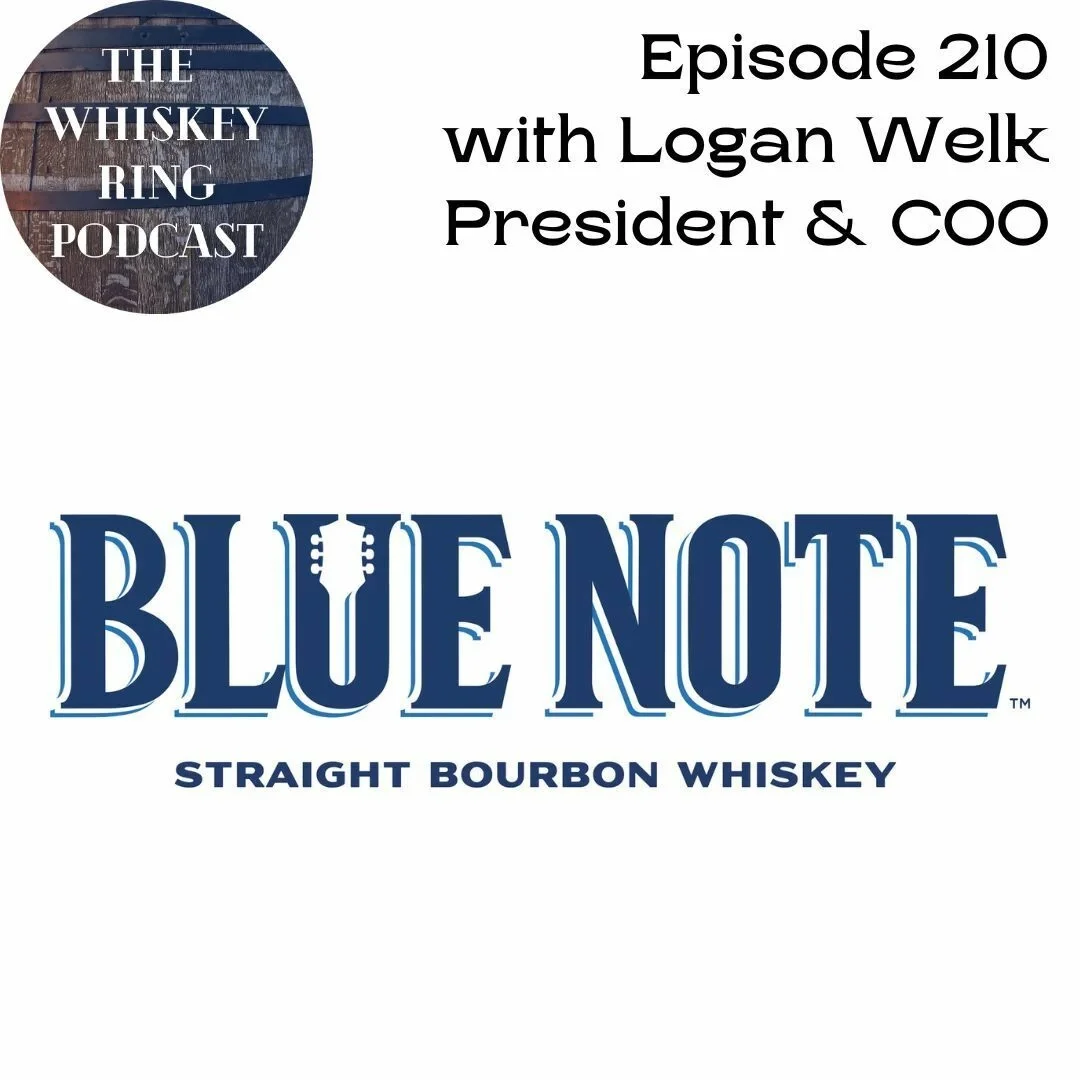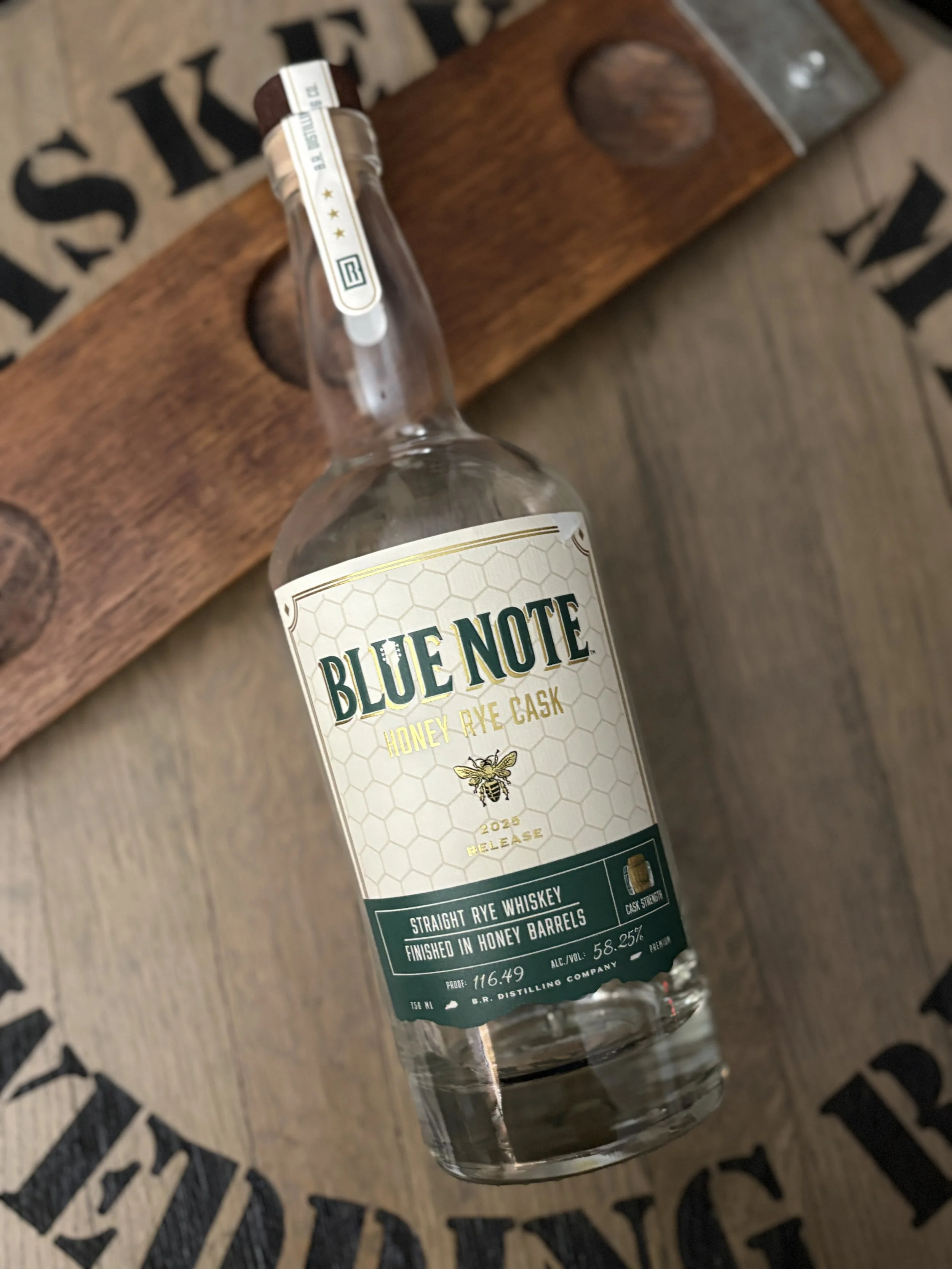Blue Note Bourbon with Logan Welk Show Notes
Notes and Reviews for Whiskey Ring Podcast Episode 210: Blue Note Bourbon with Logan Welk
From the ashes of a failed vodka company comes one of the most well-regarded blenders, finishers, and single barrel producers - Blue Note, under the heading of B. R. Distilling, in Memphis, Tennessee.
Blue Note’s meteoric rise (first production in 2018 at Green River, first releases in 2021) has coincided with several fortunate turns. The biggest was simply timing. For the first few years of their existence, B. R. Distilling was a warehousing and shipping facility that ultimately shipped to over 125 DSPs around the country, including some of the biggest names in US whiskey.
This worked to their advantage pre-COVID and especially during shutdown: while so many facilities were closed, slowed, or most importantly short on one supply or another, B. R. Distilling was fully stocked and had zero - ZERO - shortages, meaning their clients’ products and their own once they came online could not only make it to shelves but remain stocked while others ran out.
Along the way, they became well known with Green River, originally O. Z. Tyler, in Owensboro, KY. As their distilling partner, Green River distills around 400 barrels per run for Blue Note at their classic 70/21/9 bourbon or 95/5 rye mashbills. The whiskey is then aged for a year and a day in Kentucky, allowing it to be called Kentucky bourbon/rye, then is shipped to Blue Note’s facilities just north of Memphis at the confluence of the rivers. Since Green River is doing the barrel purchasing, Blue Note doesn’t have to worry about barrel shortages like other smaller producers might.
The unique microclimate, examined further in the episode, allows for slightly faster and more consistent aging than in Kentucky, so their initial releases at around 3-3.5 years old were already great bourbons and ryes. Now approaching 5-6 years old, it just keeps getting better, and they’re planning to age a few barrels as long as they’ll go to see how their whiskey reacts at 8, 9, 10+ years.
Blue Note’s products have been well-received across the board, winning Double Golds and Platinums at San Francisco. Rather than flood the award circuit in pursuit of every award imaginable, they wisely held back, entering only the most prestigious shows. After winning two of the six available Platinum awards at San Francisco in 2024, I asked Logan the question of “what’s next?”, as in what else do they have to prove?
For their core range, maybe nothing, but they’re not done exploring. Blue Note’s Crossroads Bourbon is one of the most popular French Oak-finished bourbons on the market, even if I wasn’t a huge fan of it (and listen to the episode to learn more about why and why that could be an outlier!). Their Honey Cask Rye, the release that triggered this episode happening, overtook the original Belle Meade Honey as my favorite honey cask finished American whiskey I’ve ever tried.
As is custom on the Whiskey Ring Podcast, there’s always a little something extra to consider. This time, it’s the advantages of aging in Tennessee, namely the favorable tax environment. In Kentucky, producers are taxed on aging inventory, meaning they’re paying for diminishing volumes year over year. In Tennessee, thanks to the mighty hand of Jack Daniel’s, producers are only taxed when dumping the barrels. This is one of several reasons why Blue Note’s products have been able to stay at an incredibly low price point for the quality and work involved.
You’ve also got to consider the bees: the Honey Rye cask was only three casks, which means only a few hundred bottles were available. Even if full, you’re looking at between 700-750 bottles from three casks refilled with whiskey. If your first response was “well just get more honey,” I’m with you! Logan and I talk about the unrecognized difficulty of finding enough honey to fill a 53-gallon cask: three barrels already required going outside their local apiary, and honey is both expensive and time consuming to produce. It will be a continued, regular summer release, but don’t expect it to be available year-round (and grab it when you can!).
Thank you to Logan for entering the Whiskey Ring!
If you haven’t joined the Patreon community yet, please consider doing so at patreon.com/whiskeyinmyweddingring.
If you haven’t yet, please follow Whiskey in my Wedding Ring and the Whiskey Ring Podcast on Instagram and Facebook.
Blue Note
Thank you to Blue Note for providing samples at no charge for the purposes of this interview. All opinions are my own.
Blue Note Honey Rye Cask Whiskey 2025 Release: Specs
Classification: Straight Rye Whiskey Finished in Honey Casks
Producer: Distilled at Green River Distillery, Aged at Green River and Blue Note
Mashbill: 95% Rye, 5% Malted Barley
Proof: 116.49º (58.25% ABV)
Age: NAS
Location: Distilled in Kentucky, Aged in Kentucky (for 1 Year and 1 Day) and Tennessee
Blue Note Honey Rye Cask Whiskey 2025 Release Price: $64.99
Blue Note Honey Rye Cask Whiskey 2025 Release: Tasting Notes
Eye: Translucent caramel. Oily droplets all over the glass, no legs or rims.
Nose: Sweet side of the 95/5 mash bill, honeyed rye as clear a profile as I can remember having. Oak flavor - not tannin, just flavor - comes through, carried by the honey. Clove and nutmeg-studded Hot Toddy. Hints of Earl Grey tea and stem ginger cookies.
Palate: The honey comes through beautifully, coating the rye in a light syrup that softens the sharp edges of the 95/5, especially at 116.49 proof. Warming, settles on the mid-tongue quickly with a bit of proof and pepper heat. Drinks closer to 100-105, where you know there’s proof there but it’s far away from being off-putting or distracting. Reminds me of a lemon-pepper-honey sauce, flavorful as can be. Mouthfeel is decadent and sticky without being too heavy, the syrupy texture cut by the proof, full-bodied and coating. Black tea or orange pekoe.
Finish: still honey-forward, if less sweet and more coming from the rye underneath. Remains far from the expected spice-and-herb 95/5, more Michter’s-esque in a spice-sweet balance. The astringency is nowhere to be seen and the flavors continue to stay true for several minutes.
Overall: I wish I had kept the bottle to myself, and am planning to buy two more on my next paycheck. Amazingly easy to sip at 116.49 proof, dangerously so, the honey and rye making a beautiful couple in a way only sweet-spicy pairs can do. The rye isn’t super spicy to begin with, but it packs enough punch to cut through the syrupy honey and makes clear it would survive just fine on its own. This might be the best honey-finished American whiskey I’ve ever had, surpassing the first Belle Meade Honey Bourbon release.
Final Rating: 8.6
10 | Insurpassable | Nothing Else Comes Close
9 | Incredible | Extraordinary
8 | Excellent | Exceptional
7 | Great | Well above average
6 | Very Good | Better than average
5 | Good | Good, solid, ordinary
4 | Has promise but needs work
1-3 | Let’s have a conversation










